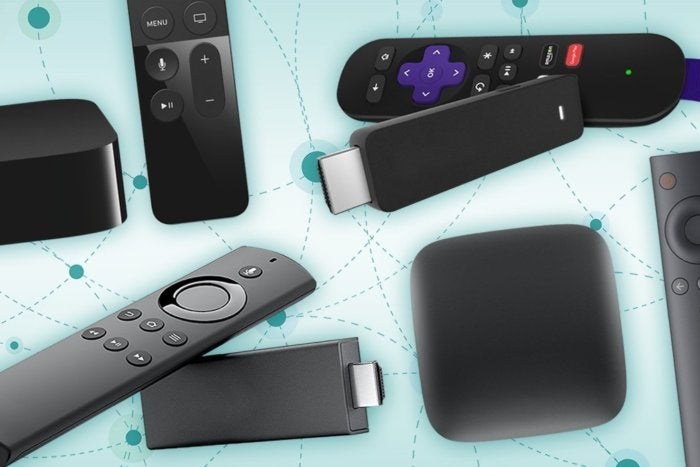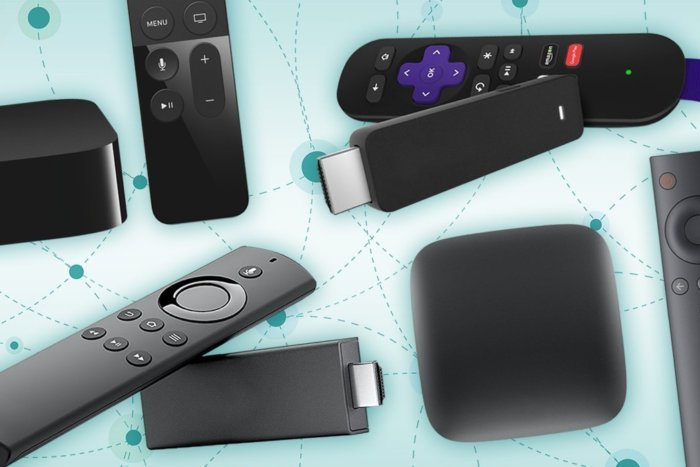Updated
Which streaming box is best for cord-cutters? And what’s the skinny on streaming sticks? Our buying guide will help you pick the right accessories for your TV.

Rob Schultz/TechHive
Today’s Best Tech Deals
Picked by TechHive’s Editors
Top Deals On Great Products
Picked by Techconnect’s Editors
Show More
It’s an excellent time to buy a media streaming device, whether you’ve just cut the cable cord or you’re looking to supplement your TV package with an online video service like Netflix, Hulu, or a newcomer like Apple TV+ or Disney+. Compared to the typical smart TV, standalone streamers such as the Amazon Fire TV Stick 4K and the all-new Nvidia Shield TV tend to have bigger app selections, faster performance, and more features. And with so much competition between device makers, the hardware is becoming faster, more capable, and more affordable.
We constantly test all the latest devices, including Roku players, Fire TV devices, Android TV devices, Apple TV, and Chromecast. We review each new generation of hardware and constantly revisit the software and app selection so we can help you determine which platform is right for you. Here are our picks for the best streaming boxes and sticks, along with all of our most current product reviews. Our recommendations will change over time as new products come to market.
Updated June 24, 2021, after much consideration, to change our top pick in this category to the Roku Express 4K.
Best 4K HDR streaming device
Roku didn’t cut any important corners with its latest streaming device. The Roku Express 4K has a dual-band Wi-Fi 5 (aka 802.11ac) Wi-Fi adapter onboard, an RF remote control that can respond to voice commands, and it of course supports video 4K resolution. And it does all that at a lower price than the Amazon Fire TV Stick 4K and the new Chromecast with Google TV. You won’t get Dolby Vision HDR, but HDR10 and HDR10+ are supported; and you can’t control the volume on a connected A/V receiver or soundbar unless they support HDMI ARC, but those are minor sacrifices compared to everything you do get with the Roku Express 4K.
Runner-up
If the second-generation Apple TV 4K didn’t cost $179, it would have been our hands-down top pick in this category. It is a fabulous piece of hardware with a feature set that no competitor can come close to, and its aluminum-wrapped remote control is as classy as the competition’s is plasticky. And while our review focuses on its media-streaming abilities, it should also be mentioned that it can also serve as a HomeKit smart-home hub and a Thread border router. Finally, Apple is unique in its efforts to protect its users’ privacy. But you’ll have to pay to play.
Best voice-controlled media streamer
Voice control is the future of the smart home, and Amazon comes closest to delivering it in the living room with its second-generation Amazon Fire TV Cube. Could it be even better? For sure, and our review points how the areas where it still falls short. But nothing else comes close—yet.
Other options to consider
The Apple TV HD is very expensive at $149, even if it does come with the same new remote that ships with the even more expensive Apple TV 4K. This 1080p streamer is a good choice for folks who’ve devoted themselves to the Apple ecosystem—including the Apple TV+ streaming service (you can read our review of Apple TV+ here)—but can’t pull the trigger on the $179 second-gen Apple TV 4K (or who don’t have a 4K TV to take advantage of it.
Chromecast with Google TV is an intriguing alternative, and it no longer depends on using your smartphone or tablet as a remote control. Best of all, the hardware now incorporates the Android TV operating system that tries hard to incorporate all of your streaming choices into a single comprehensive guide. It doesn’t quite live up to its ambition, but it comes very close.
The Nvidia Shield Android TV is relatively expensive at $149, but a new processor and AI-powered 4K upscaling make it a compelling choice for power users. The Nvidia Shield Pro version is even pricier at $200, but it can be configured to stream your personal media library to all your other devices; connected to a HDHomeRun networked tuner for use with Plex DVR, letting you record and watch free over-the-air broadcasts; and you can even plug in a USB stick and use the set-top box as a Samsung SmartThings smart home hub.
The Roku Ultra (2020) now supports both Dolby Vision and Dolby Atmos. You can stream music to it via Bluetooth, and it has a faster processor. The company hasn’t taken away any of the Ultra’s best features, including its remote control with a built-in headphone jack for private listening, programmable launch buttons, and voice control. We’re not quite as enthusiastic about Roku’s decision to stick with its approach to surfacing apps, versus surfacing content. Maybe next year?
The Roku Express 4K+ is our favorite budget-priced 4K streaming player. It includes a point-anywhere remote with voice, volume, and power controls, plus it includes dual-band 802.11ac for faster connectivity to newer wireless routers. At $40, it undercuts Amazon’s Fire TV Stick 4K and the Chromecast with Google TV by $10 without major compromises. That said, it lacks Dolby Vision HDR support, and there’s no universal guide to help users make sense of all their streaming options.
Sling TV subscribers who are also interested in receiving over-the-air broadcast TV might be interested in looking at the AirTV Player + Adapter, although we found it to be a disappointment.
What to look for in a media streaming device
Still trying to decide between all these options? Here are some additional factors to consider when making your decision, followed by a chart comparing the features of the boxes we’ve mentioned above.
Performance: In general, set-top boxes are faster than streaming sticks, and the amount you spend correlates pretty strongly with the loading speeds and smoothness you’ll get.
Playback quality and resolution: If you have a 4K or 4K HDR television, you’ll probably want a streaming box that takes full advantage of those capabilities. But these days, you won’t find any modern devices that don’t at least support 1080p resolution.
App selection: Traditionally, this has been the most important factor in choosing a streaming device, but over time app selection has started to look pretty similar no matter which device you choose, at least among major streaming services. Our app showdown chart will help you any particular service you’re interested in.
Ecosystem tie-ins: Apple apps and services are only available through Apple TV, while Fire TV devices are the most convenient way to watch Amazon Prime video, and Google’s video and music services are generally best-accessed via Chromecast or Android TV. Roku is more of a neutral party, offering apps for Amazon, Google Play Movies & TV, and several other competing video services, but it lacks the sophisticated virtual assistants and smart home controls you’ll get with other platforms.
Content discovery features: Media-streaming devices are starting to evolve beyond a static list of apps. Features like Roku Feed and the Apple TV’s “TV” app help you keep track of new arrivals, while Amazon includes recommendations directly on the Fire TV home screen. Read up on these approaches to decide which one sounds most appealing.
Private listening options: Many devices support Bluetooth headphones for when you don’t want to disturb your spouse or kids. Roku players also support wired headphones through the Roku mobile app, and through the remote control on its pricier set-top boxes.
Captive portal support: If plan to take your streaming device on the road, you may run into Wi-Fi networks that require a web browser for logging in. This is known as a “captive portal,” and not all streaming devices support it.
Remote control features: Some remote controls are loaded with buttons for fast forward, rewind, and other special functions, while others take a more minimalist approach. Some remotes can control your television’s volume, and some include microphones for voice commands. No remote is perfect, however, so take a look at the ones that are included with each box to decide what’s most important to you.
Audio codec support: An increasing number of streaming services are supporting object-based soundtracks, such as Dolby Atmos, which add height cues to surround sound. If your home audio system can also take advantage of it—and even many of today’s soundbars can—you’ll want to hear it.
Connectivity: Do you plan on connecting a USB storage device, ethernet cable, or sound system via an analog or digital optical audio cable? Make sure your streaming box has the appropriate connections. You’ll also want a device with the latest 802.11ac Wi-Fi if you’re worried about bandwidth on an overcrowded home network.
Our latest media streamer reviews
Note: When you purchase something after clicking links in our articles, we may earn a small commission. Read our affiliate link policy for more details.
Jared Newman covers personal technology from his remote Cincinnati outpost. He also publishes two newsletters, Advisorator for tech advice and Cord Cutter Weekly for help with ditching cable or satellite TV.

